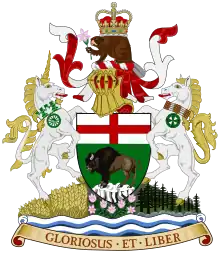| Provincial government | |
 | |
| Formation | 15 July 1870 |
|---|---|
| Founding document | Constitution Act, 1867 Manitoba Act,1870 |
| Province | |
| Country | |
| Website | www |
| Crown | |
| Sovereign | Monarch |
| Vice-regal representative | Lieutenant Governor |
| Seat | Government House |
| Legislative (Crown-in-Parliament) | |
| Legislature | Manitoba Legislature |
| Meeting place | Legislative Building |
| Executive (Crown-in-Council) | |
| Head of government | Premier |
| Appointed by | Lieutenant Governor |
| Headquarters | Winnipeg |
| Main organ | Executive Council |
| Departments | 19 departments |
| Judicial (Crown-on-the-Bench) | |
| Court | Court of Appeal |
| Seat | Law Courts Building, Winnipeg |
The powers and structure of the provincial Government of Manitoba (French: Gouvernement du Manitoba) are set out in the Constitution Act, 1867.
In modern Canadian use, the term "government" referred broadly to the cabinet of the day (formally the Executive Council of Manitoba), elected from the Legislative Assembly of Manitoba and the non-political staff within each provincial department or agency – that is, the civil service.
The Province of Manitoba is governed by a unicameral legislature, the Legislative Assembly of Manitoba, which operates in the Westminster system of government. The political party that wins the largest number of seats in the legislature normally forms the government, and the party's leader becomes premier of the province, i.e., the head of the government.
Lieutenant-Governor of Manitoba
The functions of the Sovereign, Charles III, King of Canada, known in Manitoba as the King in Right of Manitoba, are exercised by the Lieutenant Governor of Manitoba. The Lieutenant Governor is appointed by the Governor General of Canada on the recommendation of the Prime Minister of Canada, in consultation with the Premier of Manitoba.
Department
Source:[1]
- Advanced Education and Training
- Agriculture
- Consumer Protection and Government Services
- Economic Development, Investment, Trade and Natural Resources
- Education and Early Childhood Learning
- Environment and Climate Change
- Families
- Francophone Affairs
- Gender Equity
- Finance
- Health, Seniors and Long Term Care
- Indigenous Reconciliation and Northern Relations
- Intergovernmental Affairs
- Justice
- Labour and Immigration
- Mental Health and Community Wellness
- Municipal and Northern Relations
- Natural Resources and Northern Development
- Public Service Commission
- Seniors and Long term Care
- Sport, Culture, Heritage and Tourism
- Transportation and Infrastructure
See also
References
- ↑ "Departments". www.gov.mb.ca. Government of Manitoba. Retrieved September 25, 2021.